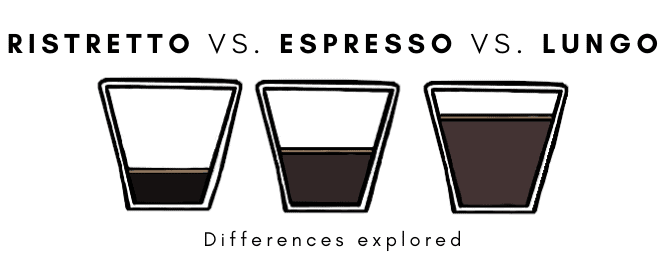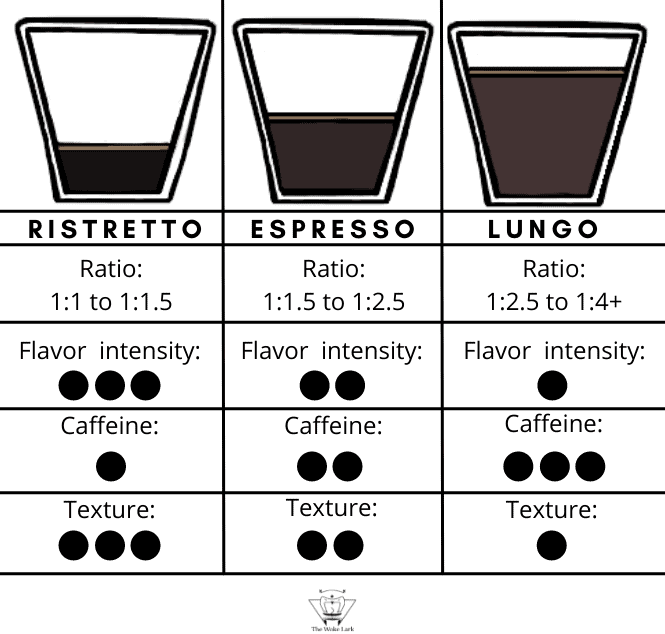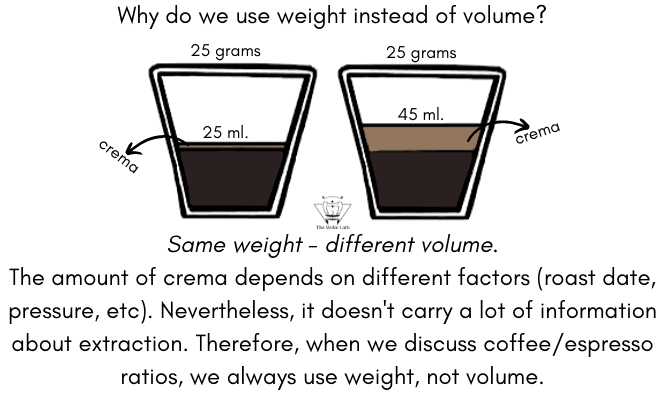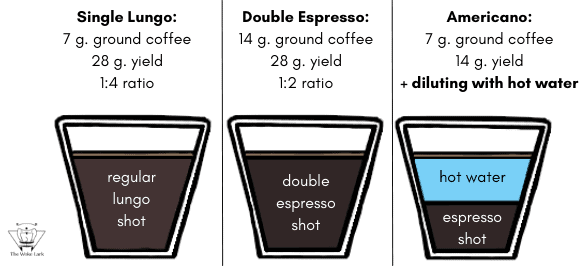If you’re a beginner who’s just stepping into the world of coffee, you may be a bit intimidated by all these drink names and coffee terms that are often used by coffee aficionados.
In this guide, I’ll clear out some of the confusion, by exploring the ristretto vs. espresso vs. lungo differences.
These drinks are all made with an espresso machine and contain the same ingredients, but they vary in volume, strength, and weight.
But which one has more caffeine – a lungo or an espresso?
How does a ristretto pod by Nespresso compare to their espresso pod?
What’s the appropriate coffee-to-water ratio for a lungo and are there any dissimilarities between this ‘streched coffee’ drink and a double espresso?
Does a barista use a ristretto shot for your morning latte, or it’s a lungo that makes its way into your cup?
I’m about to give you all the answers, so let’s dig in!
What are the Differences between Ristretto, Espresso and Lungo?
The espresso, ristretto, and lungo shots are all made by running high-pressure water through a puck of finely ground and tamped coffee.
The pressure creates a layer of crema that lays nicely on top of these beverages.
What sets these drinks apart is their coffee-to-water ratio, or in other words – the amount of pressurized water that runs through a fixed amount of coffee.
So here’s an overview of the ristretto vs. espresso vs. lungo differences:
Compared to an espresso and a lungo, a ristretto is the most concentrated and has the most intense flavor, because it’s made with the least water.
A lungo is the largest in terms of volume and weight and contains the highest amount of caffeine.
Nevertheless, the lungo has a lighter body and it’s the weakest in terms of flavor compared to a ristretto and an espresso.
Here’s a ratio and yield comparison between espresso, ristretto and lungo, prepared with a dry coffee dose of 14 grams (0.5 oz.):
| Ristretto | Espresso | Lungo | |
|---|---|---|---|
| Coffee-to-water Ratio (determines how much pressurized water passes through the coffee bed) | 1:1 to 1:1.5 | 1:1.5 to 1:2.5 | 1:2.5 to 1:4.5+ |
| Dry Dose | 14 grams/ 0.5 oz. (double) | 14 grams/ 0.5 oz. (double) | 14 grams/ 0.5 oz. (double) |
| Yield (liquid espresso) | 14 to 21 grams (0.5 to 0.75 oz.) | 21 to 35 g. (0.75 to 1.25 oz.) | 35 to 63 grams (1.25 to 2.25 oz.) |
Water is actually the solvent that dissolves the caffeine, coffee oils, flavors, and aromas.
The more hot water that’s in contact with the coffee grounds – the higher the extraction of coffee solubles.
Therefore the espresso, ristretto, and lungo differ not only by volume and weight, but also by strength, texture, and caffeine content.
Related Post: Best Water for Coffee
Ratio, Volume, Weight & Strength
More often than not, an espresso shot is made with a 1:2 to 1:2.5 ratio.
This means that if a dry coffee dose is 16 grams, you get an espresso shot of 32 to 40 grams.
The duration of extraction, the grind size, and the amount of pressurized water that passes through the grounds vary depending on the exact type of coffee beans you’re using and their flavor profile.
When dialing in a shot of espresso, the barista picks the coffee-to-water ratio that results in the best, most balanced flavor.
A ristretto is a smaller yet stronger (in terms of flavor) coffee compared to an espresso.
It’s made by running a lower quantity of pressurized water through the coffee puck.
The ristretto brew ratio varies within the 1:1 to 1:1.5 range.
A ristretto shot, made with a dose of 16 grams usually weighs between 16 and 24 grams.
The volume of your espresso, ristretto, or lungo may vary from one shot to another, even if they’re all made with the same amount of ground coffee and water.
This is because of the crema – CO2 gases, trapped in small bubbles that sit on top of the drink.
The amount of crema varies depending on how recently the coffee beans have been roasted.
The fresher the beans, the more the crema.
This means that the volume of a ristretto shot made with a dose of 16 grams may vary from 16 ml. (0.5 fl. oz.) to 25 – 30 ml. (1 fl. oz.).
In other words – crema may take up a significant portion of the drink’s volume.
Therefore your drink’s weight carries a lot more information about the extraction, and it’s a much more reliable ratio measurement.
Compared to an espresso and a lungo, a ristretto shot is often made with more finely ground coffee, and it has a very intense flavor and heavy mouthfeel.
Grinding finer when making a ristretto is necessary to keep the brew time long enough and extract all the desirable flavors.
Nevertheless, in a busy coffee shop, it’s not possible to constantly make grind adjustments in between shots.
That’s why a ristretto, lungo, and regular espresso shots are usually made with the same grind size and dose.
Ristrettos are often used in the making of lattes and cappuccinos. In these drinks, the intense ristretto flavor is nicely balanced out by the steamed and frothed milk. A double ristretto shot is also a key ingredient in another classic coffee shop beverage – the flat white.
A lungo coffee is made with the highest amount of water and a ratio of 1:2.5 to 1:4.5 (sometimes even higher).
This means that a lungo shot that’s made of 16 grams of ground coffee can weigh around 56 grams or more.
Even though it’s the weakest in terms of flavor intensity, a lungo contains more caffeine compared to an espresso and a ristretto.
The more water passes through the grounds – the more caffeine gets extracted and ends up in your cup.
Many passionate coffee lovers aren’t fans of the lungo, as it lacks body, it’s watery and often over-extracted with unpleasant bitter notes.
Especially when it’s made with dark, espresso roasted beans.
Nevertheless, in many third-wave coffee shops, lungo shots are often pulled when using lightly-roasted specialty coffee beans.
Using more hot water with this type of coffee beans improves the extraction of their subtle fruity and floral notes and balances out acidity.
This results in a complex cup of lungo coffee with pleasantly balanced flavors.
Lungo vs. Double Espresso
A single lungo shot is often confused with a double espresso shot, because of the similarity in their volume and weight.
At most coffee shops, when you order an espresso, you’ll usually get a double, which adds to the confusion.
A double shot is a shot that is prepared in a double filter basket. A single shot of espresso by the book is made with 7 to 9 grams of dry coffee. A double basket usually holds 14 to 16 grams of coffee grounds (some baskets hold up to 20 grams).
Through the use of a double basket with two spouts, you can either make two single shots, or 1 double.
Depending on the dry dose-to-water ratio you use, if you make one cup of coffee with a double basket, you will either get a double ristretto, a double espresso, or a double lungo shot (depending on the ratio).
The term ‘lungo’ in the world of coffee refers to a higher amount of water that passes through the coffee grounds when making an espresso.
The term double or ‘doppio’ refers to the weight of a coffee dose that is used in the making of a shot.
A single lungo shot, made with 7 grams of the dry dose will weigh around 28 grams, while a double espresso shot, made with 14 grams of dry dose would weigh around 28 grams.
Even though the weights of both drinks are basically the same, there would be a significant difference in their mouthfeel, caffeine content, and overall flavor.
The double espresso shot will have more texture, more intense flavor and more caffeine compared to a single lungo shot.
To pull the perfect lungo shot, a barista should grind a bit coarser to avoid over-extraction. Unfortunately, grind adjustment isn’t always an option at busy coffee shops. This is why instead of a lungo, you can get an Americano – espresso shot, diluted with hot water.
In the following picture, you can see the difference between a lungo, a double espresso, and an americano:
Related Post: Single vs. Double Shot Espresso: The Comparison
Nespresso Pods: Espresso vs. Lungo vs. Ristretto
If you have a Nespresso machine, you may be wondering what’s the difference between their espresso, lungo, and ristretto pods.
Well, it all comes down to the amount of water you need to use for each one of these.
According to the company’s instructions, a cup made with a Nespresso lungo pod should be 3.75 fl. oz. (110.9 ml), while an espresso pod by Nespresso produces a cup of 1.35 fl. oz. (40 ml).
If you make your cup of coffee with a ristretto Nespresso capsule, you should aim for 0.85 fl. oz. (25 ml) yield.
The coffee blends that are used in each one of these pods are crafted with the ratio and extraction time in mind.
So if you buy an espresso pod by Nespresso and you brew it as if it’s a lungo, you may be a bit disappointed with how watery and unpleasantly bitter your coffee tastes.
On the other hand, if you want intense coffee flavor, buying a lungo pod and brewing an ounce of coffee with it is not a good idea.
Nespresso pods actually have an intensity chart from 1 to 13.
These intensity levels indicate how bold of a flavor a pod is capable of producing. You should go for a higher number for more texture, mouthfeel, and flavor intensity.
With all being said, keep in mind that the capacity of Nespresso capsules is quite limited.
The amount that Original and VertuoLine pods hold varies between 5 and 13 grams.
For example, a lungo pod from the OriginalLine holds around 7 grams.
With this small amount of coffee, you’re instructed to brew 3.75 fl. oz. (110 ml.).
If you’re making a lungo with an espresso machine, you will be using at least 20 grams of ground coffee for this serving size.
Therefore a cup of Nespresso coffee made with a lungo pod will be quite different than an authentic lungo shot that’s made in a coffee shop.
Related Post: Best Nespresso Refillable Pods
Final Words
I guess that you now feel confident in explaining how a lungo shot compares to an espresso and a ristretto.
It’s not that hard to tell the difference between these three simple coffee drinks.
I hope that you found my guide helpful and that you learned something new through it.
Leave me a comment below if you have any questions!




